Fortaleza
| Fortaleza | |||
|---|---|---|---|
| Municipality | |||
| The Municipality of Fortaleza | |||
|
Clockwise from top: Panorama view of downtown Aratanha and Maranguape area, Theater of Jose Alencar (Teatro José de Alencar), Fortaleza Metropolitan Cathedral, A monument of the Guardian of Iracema in Iracema beach, Meireles Beach, Ingleses Bridge in Iracema Beach, Dragão do Mar Center of Art and Culture | |||
| |||
|
Nickname(s): Fortal Miami Brasileira (Brazilian Miami) Terra da Luz (Land of Light) | |||
| Motto: "Fortitudine" | |||
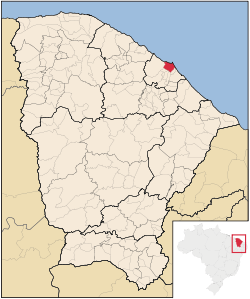 | |||
 Fortaleza Location in Brazil | |||
| Coordinates: 3°43′6″S 38°32′34″W / 3.71833°S 38.54278°WCoordinates: 3°43′6″S 38°32′34″W / 3.71833°S 38.54278°W | |||
| Country |
| ||
| Region | Northeast | ||
| State |
| ||
| Founded | April 13, 1726 | ||
| Government | |||
| • Mayor | Roberto Cláudio (PDT) | ||
| Area | |||
| • Municipality | 314.93 km2 (121.60 sq mi) | ||
| Elevation | 21 m (69 ft) | ||
| Population (2016) | |||
| • Municipality | 2,609,716 | ||
| • Rank | 5th | ||
| • Metro | 4,019,213 | ||
| Time zone | BST (UTC-3) | ||
| Postal Code | 60000-000 | ||
| Area code(s) | +55 85 | ||
| Website | Fortaleza, Ceará | ||
Fortaleza ([foʁtaˈlezɐ], locally [fɔɦtaˈlezɐ], Portuguese for Fortress) is the state capital of Ceará, located in Northeastern Brazil. It belongs to the Metropolitan mesoregion of Fortaleza and microregion of Fortaleza. Distant 2285 km (1420 miles) from Brasilia, the federal capital, the city has developed on the banks of the creek Pajeú, and its toponymy is an allusion to Fort Schoonenborch, which gave rise to the city, built by the Dutch during their second stay in place between 1649 and 1654. The motto of Fortaleza, present in its coat of arms is the Latin word Fortitudine, which in Portuguese means "strength, value, courage."
It is located on the Atlantic coast, at an average altitude of sixteen meters, with 34 km of beaches. Fortaleza has 314,930 km² and 2,609,716 inhabitants estimated in 2016, and also the biggest population density among the country's capital with 8,286.6/km². It is the largest city in Ceará in population and the fifth in Brazil. The metropolitan area of Fortaleza is the sixth most populous in Brazil and the first in the North and Northeast regions, with 4,019,213 inhabitants in 2016. It is the northeastern city with the largest area of regional influence and has the third largest urban network in Brazil in population, behind only São Paulo and Rio de Janeiro.
Fortaleza in 2013 was the twelfth richest city in the country in GDP and second in the Northeast, with 49 billion reais (US$ 21 billion). It also has the third richest metropolitan area in the North and Northeast regions. It is an important industrial and commercial center of Brazil, the eighth nation's largest municipal purchasing power. According to the Ministry of Tourism, the city reached the marks of second most desired destination of Brazil and fourth Brazilian city that receives more tourists. The BR-116, the most important highway of the country, starts in Fortaleza. The municipality is part of the Common Market of Mercosur Cities, and also the Brazilian capital which is closest to Europe, 5608 km (3484 miles) from Lisbon, Portugal. [1][2]
To the north of the city lies the Atlantic Ocean; to the south are the municipalities of Pacatuba, Eusébio, Maracanaú and Itaitinga; to the east is the municipality of Aquiraz and the Atlantic Ocean; and to the west is the municipality of Caucaia. Residents of the city are known as Fortalezenses. Fortaleza is one of the three leading cities in the Northeast region together with Recife and Salvador.[2][3]
The city was one of the host cities of the 2014 FIFA World Cup. Additionally, Fortaleza was one of the host cities of the 2013 FIFA Confederations Cup.
History
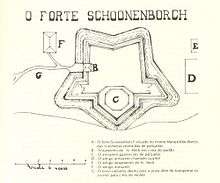
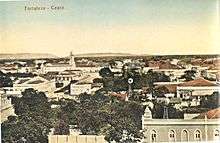
Fortaleza's history began on February 2, 1500, when Spaniard Vicente Pinzón landed in Mucuripe's cove and named the new land Santa Maria de la Consolación. Because of the Treaty of Tordesillas, the discovery was never officially sanctioned. Colonisation began in 1603, when the Portuguese Pero Coelho de Souza constructed the Fort of São Tiago and founded the settlement of Nova Lisboa (New Lisbon).[4] After a victory over the French in 1612, Martins Soares Moreno expanded the Fort of São Tiago and changed its name to Forte de São Sebastião.[5]
In 1630 the Dutch invaded the Brazilian Northeast and in 1637 they took the Fort of São Sebastião and ruled over Ceará. In battles with the Portuguese and natives in 1644 the fort was destroyed.[5] Under captain Matthias Beck the Dutch West Indies Company built a new fortress by the banks of river Pajeú. Fort Schoonenborch ("graceful stronghold") officially opened on August 19, 1649. After the capitulation of Pernambuco in 1654, the Dutch handed over this fortress to the Portuguese, who renamed it Fortaleza da Nossa Senhora de Assunção ("Fort of Our Lady of the Assumption"), after which the city of Fortaleza takes its name.[6]
Fortaleza was officially founded as a village 1726, becoming the capital of Ceará state in 1799.[7]
During the 19th century, Fortaleza was consolidated as an urban centre in Ceará, supported by the cotton industry. In 1824, the city was targeted by the revolutionaries of Confederation of the Equator. Between the years 1846 and 1877, the city went through a period of enrichment, economic and infrastructural improvement. This included the export of cotton and the development of diverse workmanships, such as the creation of the 2 secondary schools, the Ceará and Mucuripe Lighthouse in 1845, Santa Casa de Misericórdia de Fortaleza in 1861, Prainha Seminary in 1864, Public Library in 1867 and the Public transportation network in 1870, which began with the construction of Railroad of Baturité.[8]
In the twentieth century, Fortaleza underwent significant urban changes, with improvements and the rural exodus to the city, with growth mostly towards the end of the decade of 1910, this made the city the seventh most populated city in Brazil. In 1922, Fortaleza reached its first hundred thousand inhabitants with the annexation of the cities of Messejana and Parangaba, now important districts of the city.[9] In 1954, the first university in the city was created, the Universidade Federal do Ceará(UFC) .[10]
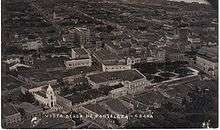
In 1983 DIF I started to integrate the territory of the new city of Maracanaú, which, just some years ago, was made again part of the Greater Fortaleza (the city's Metropolitan area). In the 1980s, Fortaleza exceeded Recife in population terms, becoming the second most populous city in Northeastern Brazil, with 2,571,896 inhabitants.[11]
During the political awakening that followed the military regime, the people elected the city's first woman mayor, Maria Luíza Fontenele of the Brazilian Workers' Party, which meant that the city administration was controlled by a party of the centre-left. At the end of the twentieth century, the administration of the city hall and the city underwent a range of structural changes with the opening of several avenues, hospitals, cultural spaces and it became one of the main tourist destinations in the Northeast and in Brazil.[12]
Geography
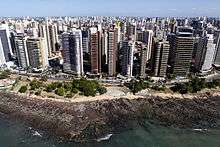
Climate
Fortaleza has a typical tropical climate, specifically a tropical wet and dry climate, with high temperatures and high relative humidity throughout the year. However, these conditions are usually relieved by pleasant winds blowing from the ocean. Average temperatures are not much different throughout the year. December is the warmest month, with a high of 30.7 °C (87.3 °F)[13] and low of 24.6 °C (76.3 °F).[14] The rainy season spans from February to May, with rainfall particularly prodigious in March and April.[15] The average annual temperature is 26.6 °C (79.9 °F).[16] The relative humidity in Fortaleza is 79%,[17] with average annual rainfall of 1,608.4 millimetres (63.32 in).[15]
Fortaleza weather is unique in that there is usually rain during the first seven months of the year from January to July. During this period, relative humidity is high. Fortaleza's climate is usually very dry from August to December, with very little rainfall.[15][17]
| Climate data for Fortaleza (1961–1990) | |||||||||||||
|---|---|---|---|---|---|---|---|---|---|---|---|---|---|
| Month | Jan | Feb | Mar | Apr | May | Jun | Jul | Aug | Sep | Oct | Nov | Dec | Year |
| Record high °C (°F) | 37.7 (99.9) |
33.3 (91.9) |
32.8 (91) |
32.6 (90.7) |
32.8 (91) |
31.8 (89.2) |
33 (91) |
34.4 (93.9) |
32.7 (90.9) |
33.4 (92.1) |
33 (91) |
33.2 (91.8) |
37.7 (99.9) |
| Average high °C (°F) | 30.5 (86.9) |
30.1 (86.2) |
29.7 (85.5) |
29.7 (85.5) |
29.9 (85.8) |
29.6 (85.3) |
29.5 (85.1) |
29.9 (85.8) |
30.2 (86.4) |
30.5 (86.9) |
30.7 (87.3) |
30.7 (87.3) |
30.1 (86.2) |
| Daily mean °C (°F) | 27.1 (80.8) |
26.9 (80.4) |
26.4 (79.5) |
26.2 (79.2) |
26.2 (79.2) |
25.8 (78.4) |
25.6 (78.1) |
26 (79) |
26.4 (79.5) |
26.9 (80.4) |
27.2 (81) |
27.3 (81.1) |
26.6 (79.9) |
| Average low °C (°F) | 24.4 (75.9) |
24 (75) |
23.6 (74.5) |
23.4 (74.1) |
23.3 (73.9) |
22.8 (73) |
22.4 (72.3) |
22.7 (72.9) |
23.4 (74.1) |
24.1 (75.4) |
24.4 (75.9) |
24.6 (76.3) |
23.6 (74.5) |
| Record low °C (°F) | 20 (68) |
21.2 (70.2) |
20.2 (68.4) |
20 (68) |
20.6 (69.1) |
20.3 (68.5) |
19.4 (66.9) |
19.4 (66.9) |
20.5 (68.9) |
21 (70) |
21.3 (70.3) |
21 (70) |
19.4 (66.9) |
| Average rainfall mm (inches) | 119.1 (4.689) |
204.6 (8.055) |
323.1 (12.72) |
356.1 (14.02) |
255.6 (10.063) |
141.8 (5.583) |
94.7 (3.728) |
21.8 (0.858) |
22.7 (0.894) |
13 (0.51) |
11.8 (0.465) |
44.1 (1.736) |
1,608.4 (63.323) |
| Average rainy days (≥ ≥ 1 mm) | 11 | 15 | 22 | 21 | 19 | 14 | 10 | 5 | 5 | 4 | 3 | 6 | 132 |
| Average relative humidity (%) | 78.1 | 81.4 | 84.7 | 85.2 | 83.6 | 81 | 78.8 | 75.3 | 74.4 | 74 | 73.7 | 75.9 | 78.8 |
| Mean monthly sunshine hours | 225.2 | 182.3 | 150 | 157.1 | 208.4 | 238.7 | 268.3 | 295.9 | 281.6 | 291.4 | 282.2 | 262.3 | 2,843.4 |
| Source: Brazilian National Institute of Meteorology (INMET).[16][13][14][15][18][19][17][20][21] | |||||||||||||
Vegetation
In Fortaleza there are some remaining areas of mangrove, in preserved areas.[22][23] The municipality contains the 3,320 hectares (8,200 acres) Pedra da Risca do Meio Marine State Park created in 1997 to support an offshore area of reefs of ecological and tourist importance.[24]
Demographics
.jpg)
.png)
According to the 2010 IBGE Census, there were 2,315,116 people residing in the city of Fortaleza.[25] The census revealed the following numbers: 1,403,292 Pardo (multiracial) people (57.2%), 901,816 White people (36.8%), 110,811 Black people (4.5%), 33,161 Asian people (1.4%), 3,071 Amerindian people (0.1%).[26]
In 2010, the city of Fortaleza was the 5th most populous city proper in Brazil, after São Paulo, Rio de Janeiro, Salvador, and Brasília.[27]
In 2010, the city had 433,942 opposite-sex couples and 1,559 same-sex couples. The population of Fortaleza was 53.2% female and 46.8% male.[26]
The following cities are included in the metropolitan area of Fortaleza (ordered by population): Fortaleza, Caucaia, Maracanaú, Maranguape, Aquiraz, Pacatuba, Pacajus, Horizonte, São Gonçalo do Amarante, Itatinga, Guaiúba and Chorozinho.[28]
According to a genetic from 2011, 'pardos' and whites' from Fortaleza, which comprise the largest share of the population, showed up a degree of European ancestry of about 70%, being the rest basically divided between Native American and African ancestries.[29] A 2015 study, however, found out the following composition in Fortaleza: 48,9% of European contribution, 35,4% of Native American input and 15,7% of African ancestry.[30]
Religion
The prevailing religion of Fortaleza is the Roman Catholic branch of Christianity, due to the influence of Portuguese settlers and missionaries during the colonial rule of Brazil.
| Religious affiliation | Percentage | Number |
|---|---|---|
| Catholic | 79.0% | 1,691,487 |
| Protestant | 12.58% | 269,469 |
| No religion | 5.99% | 128,190 |
| Kardecist | 0.83% | 17,780 |
| Jehovah's Witnesses | 0.64% | 13,758 |
| Other religions | 0.7% | 15,923 |
Economy
Fortaleza's GDP is R$42 billion, arising from its diversified commerce, industry and tourism. Downtown Fortaleza, or Centro, is where most commercial activities happen. Monsenhor Tabosa Avenue, near Iracema Beach and Aldeota neighborhood are significant commercial districts as well. Fortaleza has two of the ten biggest malls in the country, Shopping Iguatemi and RioMar Shopping, the seventh and the eighth largest, respectively. Fortaleza is home to several other malls, the most significant being RioMar Norte, Shopping Del Paseo, North Shopping Jóquei, Parangaba Shopping, Via Sul, Varanda Mall and Jardins Open Mall.[32]
The manufacturing industry produces footwear, textiles, leather-derived items, and processed food and beverages. Presently, Fortaleza offers a wide variety of event spaces, allowing different kinds of events to be promoted, ranging from small business meetings to national and international conventions and fairs that receive thousands of people. The biggest and best-equipped event venue available in the Northeast of Brazil is the Event Center of Ceará (CEC) in Fortaleza, opened in 2012. Additionally, many hotels, business centres and other venues also offer adequate spaces for different types of gatherings. Now-defunct TAF Airlines used to have its headquarters in Fortaleza.[33]
.jpg)
The GDP for the city was R$42,010,111,000 (2011).[34] The per capita income for the city was R$16,962.89 (2011).[35]
Culture
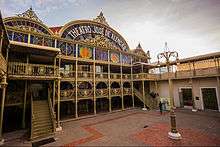
Since the end of the 19th century, the city has been home to various cultural institutions. The Instituto do Ceará (Ceará Institute) was established in 1887, and conducts research in history, geography and anthropology. The Academia Cearense de Letras (Ceará Academy of Letters) was the first institution of the sort in the country, established on August 15, 1894. In 1892, Fortaleza was the site of a cultural movement of literary expression called "Spiritual Bakery". There are many other cultural centres, including the Banco do Nordeste Cultural Centre and the Dragão do Mar Center of Art and Culture. The folklore of Fortaleza is rich and diverse, and has roots in a mixture of beliefs originating from white colonisers and native groups. Minor, but also considered important, are Syrian-Lebanese and African traditions.
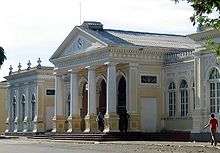
Some of the cultural manifestations are:

- Quadrilhas juninas: hundreds of large groups of traditional folk dances organised to make presentations, usually to the sound of forró, during the festas juninas, in the month of June (and also July).
- Bumba-meu-boi or Boi-Ceará: songs and dances inspired by legends about a mythical ox, with Portuguese roots.
- Torém: dance originated from the Tremembé natives.
- Violeiros, cantadores and emboladores: musical manifestations expressing social criticism, with typical Northeastern origins.
- Maracatu: Dance and music, the Fortaleza maracatu belongs to the Baque Virado or Nação styles and is celebrated during carnivals.
- Dança do coco: originated by Afro-Brazilians. On the coast it is for men only, while in the hinterland it is danced in pairs.
Carnival

Fortaleza Carnival season is not as famous as that in other northeastern cities like Salvador or Recife, as the local population prefer to spend the holiday at others beach cities of Ceará. Through the streets of Fortaleza, the Carnival brings the samba together with festivities as a celebration of Fortaleza's past and diverse culture. It is particularly notable for its unique style of maracatu known as maracatu cearense.[36]
Landmarks

Fortaleza is the home of numerous landmarks. They include:
- Theatro José de Alencar;
- Farol do Mucuripe;
- Fortaleza's Cathedral;
- Estátua de Iracema;
- Forte Nan de Praire Statue;
- Forte de Nossa Senhora da Assunção;
- Palácio da Luz;
- Castelão football stadium
Cuisine
Brazilian cuisine includes feijoada, churrasco (barbecue), rice and beans. There are some dishes which are typical of the Northeast of Brazil, such as macaxeira (cassava), tapioca, carne de sol, but the most typical food of Ceará is baião-de-dois (a kind of risotto with beans, and cheese).
Tourism
.jpg)

Fortaleza is a big tourist destination for the domestic Brazilian market. The city has several major hotels which are rated as five stars. In addition there are several four star hotels as well as inns. Further along the beach front is the new pier and later the roller skating area close to Iracema beach.
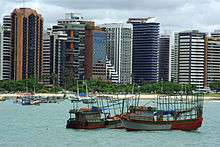
Scuba diving is possible in the area of Pedra da Risca do Meio Marine State Park, a marine protected area located about 10 nautical miles from the shoreline of Fortaleza.[37]
Urban beaches
Fortaleza has about 25 kilometres (16 mi) of urban beaches. From North to South, the urban beaches of Fortaleza are Iracema, Meireles, Mucuripe and Praia do Futuro. Each beach has its own peculiarities:
- Iracema is the Bohemian beach, with bars and nightclubs;[38]
- Mucuripe is the place where jangadas can be found. Still used by fishermen to go into high seas, jangadas can be seen along the way during the afternoon and evenings, and returning from the sea in the morning; part of the catch of the day is sold in an old style fish market.[39]
Parks

Transport
International Airport
The passenger terminal at Pinto Martins – Fortaleza International Airport is totally air-conditioned and has four levels. There are direct flights to Lisbon, Milan, Frankfurt and Amsterdam. All major destinations in Brazil are also connected to Fortaleza.
Roads
The system of traffic monitoring is known by the acronym CTAFOR,[40] which stands for "Controle de Tráfego em Área de Fortaleza" (Traffic Control of the Area of Fortaleza).
Subway

MetroFor is the 43 kilometres (27 mi) rapid transit system for the city of Fortaleza.[41] The system began operation on October 24, 2012. Its lines have roots in the old system of the Brazilian Company of Urban Trains (CBTU) in Fortaleza, which were adapted to service the new underground. The system has 28 stations: 18 on the south line, four of which are underground, and 10 on the west line beyond the central station. A new East line, totally underground, started to be built on February 2014.
Bus stations
Engenheiro João Tomé Bus station is the Fortaleza Bus terminal official name. Was Contstructed in 1973. A daily average of over 8,000 passengers. 35 Bus companies and close to 200 bus lines. The bus station is centrally located within the city limits. Only 3 kilometres (1.9 mi) from the city centre and 5 kilometres (3.1 mi) from Praia de Iracema Beach. Fortaleza bus station is accessible by at least 2 city bus lines: Av. Borges de Melo I and Av. Borges de Melo II. Fortaleza has multiple Bus Rapid Transit, or BRT, lines throughout the city and has plans to extend this network of transportation (BRTBrasil.org) [42]
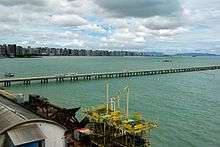
Ports
Fortaleza Harbour is an artificial port located in the Mucuripe inlet. The quay is 1,054 metres (3,458 ft) long. It contains an exclusive mooring platform for oil tankers. Its warehouse area is 6,000 square metres (65,000 sq ft) in area and offers more than 100,000 square metres (1,100,000 sq ft) for container placing.
Bike lanes
Fortaleza officially has 116.4 kilometres (72.3 mi) of bike lanes.[43]
Sports
.jpg)
The most popular sport in Fortaleza, like the rest of Brazil, is football (soccer). The main games of the Ceará State Championship are played in Fortaleza. There are several association football clubs in the city. The most important ones are Ceará SC, Fortaleza EC and Ferroviário AC. The city is host to the Free Kick Masters Tournament on December 28, 2013 and also one of the host cities of the 2013 FIFA Confederations Cup and 2014 FIFA World Cup, for which Brazil was the host nation.
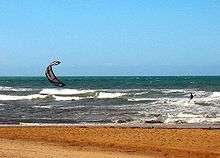
In addition to football, Fortaleza is also home to nautical sports. Strong winds make Praia do Futuro an excellent place for this kind of practice. Fortaleza commonly hosts world competitions of surfing, windsurfing and kitesurfing. The city has also traditions in another sports, as beach volleyball, Table tenis, Skateboard, Surf, Bodysurf and Futsal.
.jpg)
Futuro Beach, means the beach of the future and this is most ideal place for water sports. Kitesurfing, windsurfing and surfing are the most popular water sports in the city. The beach of Praia de Futuro is the favorite spot for water sports enthusiasts because of the strong winds. Another reason that water sports is thriving in Fortaleza especially in this beach is because of the low equipment costs available.
Notable people
- José de Alencar, famous Brazilian writer from the 19th century
- Alberto Nepomuceno, famous Brazilian composer from the 19th century
- Rachel de Queiroz, first female writer in Academia Brasileira de Letras
- André Diamant, international chess grandmaster
- Casimiro Montenegro Filho, founder of ITA
- Maurício Peixoto, mathematician, one of the founders of IMPA
- Gilberto Câmara, former director of Brazil's National Institute for Space Research (INPE)
- Hélder Câmara, Roman Catholic Archbishop nominated for the Nobel Peace Prize
- Castelo Branco, former president of Brazil (1964–67)
- Karim Aïnouz, film director
- Ed Lincoln, musician and composer
- Shelda Bede, beach volleyball player and olympic medalist
- Raffael, professional footballer
- Ronny Araújo, professional footballer
- Mário Jardel, retired professional footballer
- Marcus Aurélio, mixed martial arts professional
- Wilson Gouveia, mixed martial arts professional
- Thiago Alves, mixed martial arts professional
- Hermes França, mixed martial arts professional
- Jorge Gurgel, mixed martial arts professional
- Heloneida Studart, writer, politician, women's rights advocate
International relations
Twin towns – Sister cities
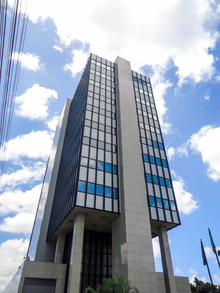
Fortaleza is twinned with:
.png)
See also
References
- ↑ Population Fortaleza (Portuguese)
- 1 2 Garmany, Jeff (2011). "Situating Fortaleza: Urban space and uneven development in northeastern Brazil". Cities. Elsevier. 28 (1): 45–52. doi:10.1016/j.cities.2010.08.004.
- ↑ "Global city GDP 2013-2014". Brookings Institution. Retrieved 1 August 2015.
- ↑ History of Fortaleza (English)
- 1 2 History of Fortaleza and Ceará at Fortaleza, Ceará site
- ↑ The Fortress of Nossa Senhora da Assunção at Fortaleza, Ceará site
- ↑ "Fortaleza". 2014 FIFA World Cup Brazil. FIFA. Retrieved 14 May 2014.
- ↑ History of Fortaleza (English)
- ↑ History of Fortaleza (English)
- ↑ UFC (English)
- ↑ History of Fortaleza (English)
- ↑ History of Fortaleza (English)
- 1 2 "Temperatura Máxima (°C)" (in Portuguese). Brazilian National Institute of Meteorology. 1961–1990. Archived from the original on May 4, 2014. Retrieved August 19, 2014.
- 1 2 "Temperatura Mínima (°C)" (in Portuguese). Brazilian National Institute of Meteorology. 1961–1990. Archived from the original on May 4, 2014. Retrieved August 19, 2014.
- 1 2 3 4 "Precipitação Acumulada Mensal e Anual (mm)" (in Portuguese). Brazilian National Institute of Meteorology. 1961–1990. Archived from the original on May 4, 2014. Retrieved August 19, 2014.
- 1 2 "Temperatura Média Compensada (°C)" (in Portuguese). Brazilian National Institute of Meteorology. 1961–1990. Archived from the original on May 4, 2014. Retrieved August 19, 2014.
- 1 2 3 "Umidade Relativa do Ar Média Compensada (%)". Brazilian National Institute of Meteorology. Archived from the original on May 4, 2014. Retrieved August 19, 2014.
- ↑ "Número de Dias com Precipitação Mayor ou Igual a 1 mm (dias)". Brazilian National Institute of Meteorology. Archived from the original on May 4, 2014. Retrieved August 19, 2014.
- ↑ "Insolação Total (horas)". Brazilian National Institute of Meteorology. Archived from the original on May 4, 2014. Retrieved August 19, 2014.
- ↑ "Temperatura Máxima Absoluta (ºC)". Brazilian National Institute of Meteorology (Inmet). Archived from the original on June 21, 2014. Retrieved August 19, 2014.
- ↑ "Temperatura Mínima Absoluta (ºC)". Brazilian National Institute of Meteorology (Inmet). Archived from the original on June 21, 2014. Retrieved August 19, 2014.
- ↑ Manguezal do Rio Ceará (Portuguese)
- ↑ Manguezal do Rio Cocó (Portuguese)
- ↑ Parque Estadual Marinho da Pedra da Risca do Meio, SEMACE, Governo do Estado do Ceará, retrieved 2016-11-28
- ↑ 2010 IGBE Census (Portuguese)
- 1 2 2010 IGBE Census (Portuguese)
- ↑ The largest Brazilian cities – 2010 IBGE Census (Portuguese)
- ↑ Fortaleza (English)
- ↑ http://www.plosone.org/article/info%3Adoi%2F10.1371%2Fjournal.pone.0017063
- ↑ http://www.nature.com/ejhg/journal/v23/n7/full/ejhg2014215a.html
- ↑ "Sistema IBGE de Recuperação Automática – SIDRA". Sidra.ibge.gov.br. Retrieved April 17, 2010.
- ↑ Shopping in Fortaleza, Brazil (English)
- ↑ "TAF prepara sua expansão nacional." Gazeta Mercantil. October 7, 2007. Retrieved on November 21, 2009.
- ↑ GDP (PDF) (in Portuguese). Fortaleza, Brazil: IBGE. 2011. p. 30. Retrieved September 3, 2014.
- ↑ Per capita income (PDF) (in Portuguese). Fortaleza, Brazil: IBGE. 2011. Retrieved September 3, 2014.
- ↑ Fortaleza carnival (English)
- ↑ Soares, Marcelo de Oliveira; Paiva, Carolina Cerqueira de; Freitas, João Eduardo Pereira de; Lotufo, Tito Monteiro da Cruz (2011), "Gestão de unidades de conservação marinhas: o caso do Parque Estadual Marinho da Pedra da Risca do Meio, NE – Brasil" (PDF), Revista da Gestão Costeira Integrada, 11 (2), retrieved 2016-11-28
- ↑ Iracema beach (English)
- ↑ Mucuripe Fortaleza (Portuguese)
- ↑ "Autarquia Municipal de Trânsito". CTAFOR. Retrieved 2014-02-09.
- ↑ "Mapa das Linhas - Metrô de Fortaleza". Metrô de Fortaleza - METROFOR. Retrieved 2013-08-22.
- ↑ "BRT Brasil". Associação Nacional das Empresas de Transportes - NTU. Retrieved 2015-01-29.
- ↑
- ↑ "Pragmatismo marca gestão de Luizianne em Fortaleza". Clipping do Ministério do Planejamento. 17 April 2007. Retrieved July 14, 2008.
- ↑ "Sister City of Miami Beach — City Commission Meeting". City of Miami Beach. 26 May 2004. Retrieved July 14, 2008.
- ↑ http://www.opovo.com.br/app/fortaleza/2016/06/30/noticiafortaleza,3630505/fortaleza-se-torna-cidade-irma-de-lisboa.shtml. Missing or empty
|title=(help) - ↑ "La Força Expedicionária Brasileira — F.E.B". MUSEO STORICO DI MONTESE. Retrieved July 14, 2008.
- ↑ "Lei 9083 Considera Cidade Irmã de Fortaleza a cidade de Natal" (PDF). Diário Oficial do Município de Fortaleza. 1 June 2006. Archived from the original (PDF) on July 3, 2007. Retrieved July 14, 2008.
- ↑ "Praia gemina-se com Fortaleza no seu 150º aniversário". Embaixador de Cabo Verde em Brasília. 29 April 2008. Retrieved July 14, 2008.
- ↑ "Online Directory: Brazil, Americas". Sister Cities International. 2008. Archived from the original on April 16, 2008. Retrieved July 14, 2008.
- ↑ "O 1º Intercâmbio Econômico e Cultural Afro-Brasileiro possibilita negócios entre Senegal e Ceará". APRECE. 2006. Retrieved July 14, 2008.
External links
- (Portuguese) Fortaleza City Council home page
- (Portuguese) Fortaleza Tourism Office home page



_1.jpg)